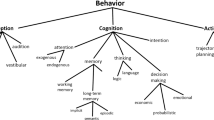Abstract
According to a prominent recent report, guppies collected from sites lacking predators are inferior in every aspect of their life history profile to those evolved in other, nearby sites with predators present. This is an exception to two classical predictions of evolutionary theory: that low extrinsic mortality should be associated with longer life span, and that higher fertility should be associated with shorter life span. Some theorists have tried to accommodate this and other anomalous results within the standard framework, but we argue that the exceptions they carve out do not explain the results at hand. In fact, the findings suggest that population regulation has been selected at the group level, though this is a mechanism that most theorists regard with suspicion. We conclude by relating the present result to other experiments that seem to point in the same direction.


Similar content being viewed by others
References
Abrams PA (1993) Does increased mortality favor the evolution of more rapid senescence? Evolution 47(3):877–887
Austad SN (1993) Retarded senescence in an insular population of virginia opossums (Didelphis virginiana). J Zool 229:695–708
Austad SN, Fischer KE (1991) Mammalian aging, metabolism, and ecology - evidence from the bats and marsupials. J Gerontol 46(2):B47–B53
Bell G (1982) The masterpiece of nature: the evolution and genetics of sexuality. Croom Helm, London
Bredesen DE (2004) The non-existent aging program: how does it work? Aging Cell 3(5):255–259
Bryant MJ, Reznick D (2004) Comparative studies of senescence in natural populations of guppies. Am Nat 163(1):55–68
Charlesworth B (1994) The evolution of life histories. Cambridge University Press, Cambridge
Endler JA (1980) Natural selection on color patterns in Poecilia reticulata. Evolution 34:76–91
Fisher RA (1930) The genetical theory of natural selection. Clarendon Press, Oxford
Gray DA, Cade WH (2000) Senescence in field crickets (Orthoptera; Gryllidae): examining the effects of sex and a sex-biased parasitoid. Can J Zool-Rev Canadienne De Zoologie 78(1):140–143
Keller L, Genoud M (1997) Extraordinary lifespans in ants: a test of evolutionary theories of ageing. Nature 389(6654):958–960
Kenyon C (2001) A conserved regulatory system for aging. Cell 105(2): 165–168
Leroi AM, Chippindale AK, Rose MR (1994) Long-term laboratory evolution of a genetic life-history tradeoff in Drosophila melanogaster. 1. The role of genotype-by-environment interaction. Evolution 48:1244–1257
Medawar PB (1952) An unsolved problem of biology. H. K. Lewis, London
Miller RA, Dysko R et al (2000) Mouse (Mus musculus) stocks derived from tropical islands: new models for genetic analysis of life history traits. J Zool 250:94–104
Miller RA, Harper JM et al (2002) Longer life spans and delayed maturation in wild-derived mice. Exp Biol Med 227(7):500–508
Mitteldorf J (2004) Ageing selected for its own sake. Evol Ecol Res 6:937–953
Mitteldorf J (2006) Chaotic population dynamics and the evolution of ageing: proposing a demographic theory of senescence. Evol Ecol Res 8:561–574
Mitteldorf J, Pepper J (2007) Senescence as an adaptation to limit the spread of disease. Theor Pop Biol (in press)
Pepper JW, Smuts BB (2000) The evolution of cooperation in an ecological context: an agent-based model. In: Kohler TA, Gumerman GJ (eds) Dynamics in human and primate societies: agent-based modeling of social and spatial processes. Oxford University Press, Oxford, pp 45–76
Reznick D, Buckwalter G et al (2001) The evolution of senescence in natural populations of guppies (Poecilia reticulata): a comparative approach. Exp Gerontol 36(4–6):791–812
Reznick DN, Bryant MJ, Roff D, Ghalambor CK, Ghalambor DE (2004) Effect of extrinsic mortality on the evolution of senescence in guppies. Nature 431:1095–1099
Ricklefs RE (1998) Evolutionary theories of aging: Confirmation of a fundamental prediction, with implications for the genetic basis and evolution of life span. Am Nat 152(1):24–44
Rose MR (1991) Evolutionary biology of aging. Oxford University Press, Oxford
Stearns S (1992) The evolution of life histories. Oxford Press, Oxford
Van Valen L (1973) A new evolutionary law. Evol Theory 1:1–30
Williams GC (1957) Pleiotropy, natural selection and the evolution of senescence. Evolution 11:398–411
Williams PD, Day T (2003) Antagonistic pleiotropy, mortality source interactions, and the evolutionary theory of senescence. Evolution 57:1478–1488
Acknowledgments
We thank a very knowledgeable anonymous referee for many helpful comments
Author information
Authors and Affiliations
Corresponding author
Rights and permissions
About this article
Cite this article
Mitteldorf, J., Pepper, J.W. How can evolutionary theory accommodate recent empirical results on organismal senescence?. Theory Biosci. 126, 3–8 (2007). https://doi.org/10.1007/s12064-007-0001-0
Received:
Accepted:
Published:
Issue Date:
DOI: https://doi.org/10.1007/s12064-007-0001-0




